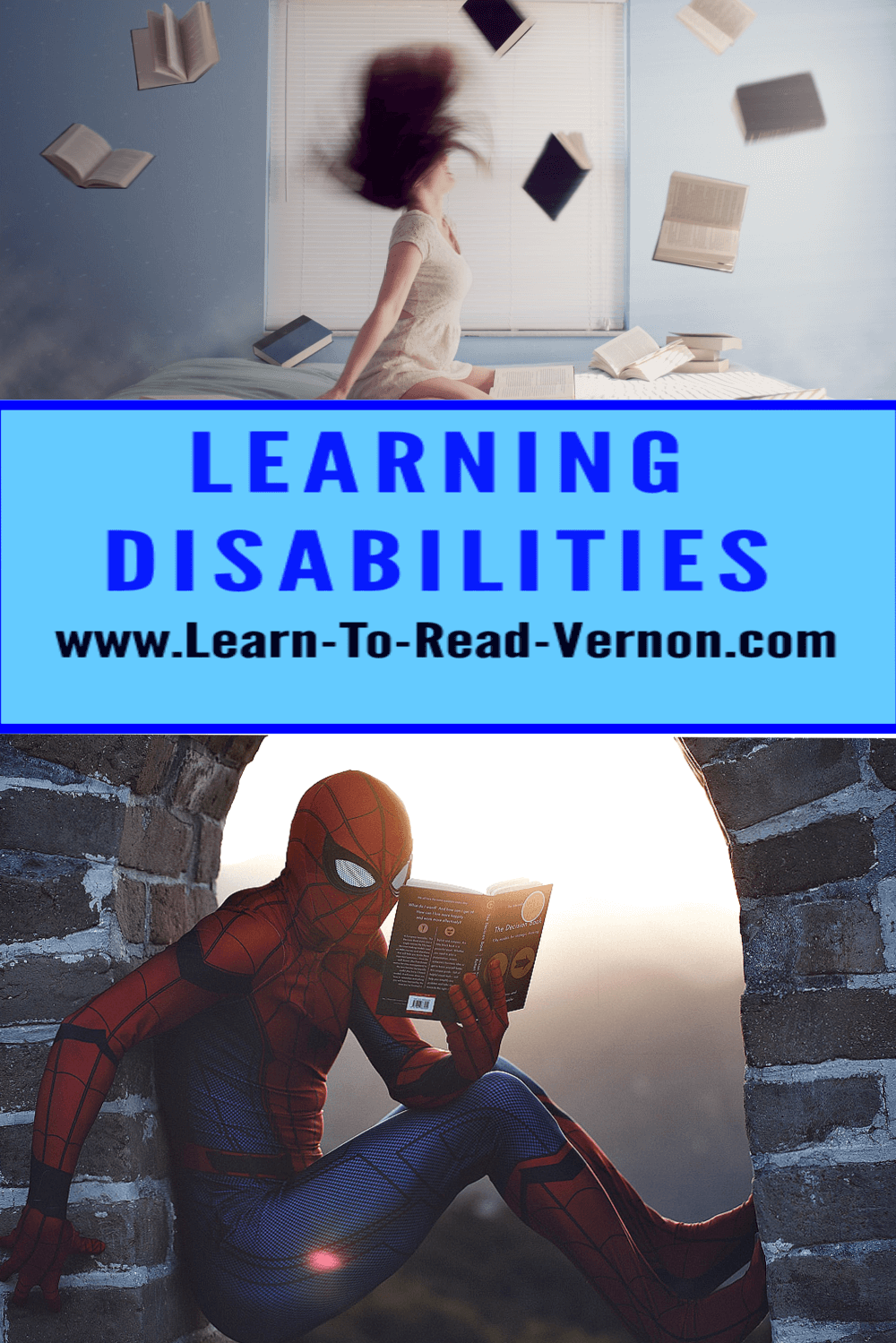| site search by freefind | advanced |
- Home
- Learn To Read
- Reading With Learning Disabilities
Reading
With Learning Disabilities
By Academic Associates founder Cliff Ponder
Copyright 1997 by Cliff Ponder
Note: If you purchase anything from links on this site, I may make a commission.
Join our Facebook page.
One of the most commonly diagnosed learning disabilities is dyslexia. The term "dyslexia" is derived from two words: "dys," meaning "can't" or "unable", and "lexicon," which pertains to written words. A lectionary is a dictionary. So the literal meaning of dyslexia is "unable to read written words." But clinical dyslexia is a neurological condition in which the brain distorts the images it receives from the eyes. The truly dyslexic person may see the last letter of a word first and the first letter last, or he may see words in a mirror image, as you would if you held a word up to a mirror, or in some other confused order. Clinical dyslexia is rare, but the diagnosis of clinical dyslexia is quite common.
Many people appear to have dyslexia when they reverse the sounds of letters, and are unable to distinguish between words such as "was" and "saw." It is sometimes assumed that such persons are reversing the letters within their brains, when the real problem is that they have not been taught that letters make individual sounds, and that the sounds of those letters must be processed in order from left to right. Thus a student may say "saw" for "was" or vice-versa because they haven't been taught that the order in which the letters appear makes a difference. Many students we have taught were diagnosed as dyslexic because they had not been taught that very simple, basic principle. They never learned that letters have sounds that must be rendered in order from left to right. "Was" and "saw" have the same letters in them, and if the order didn't matter, either pronunciation would appear to be acceptable.
Learning Disabilities: A Recipe For Disaster
Prior to the 1930s, there were few problems with America's schools, and the diagnosis of dyslexia was reserved for those who had the classic symptoms of dyslexia. Nearly everyone who attended school learned to read within a reasonable time. Over 95% of the populace were fully literate, and about 90% of our urban minorities were fully literate. The education system was the envy of the world, and other countries sent delegations to study it. There were only a few special education classes, and these were reserved for the severely mentally-handicapped. But all this was to change.
Under the influence of prominent educators, a movement to abandon the phonics method began late in the nineteenth century. There was an immediate outcry by many in the education community, warning of dire consequences if this ancient but successful method were suddenly replaced with an untested methods, but the "experts" prevailed and the schools eventually caved in. By the 1930s the time-proven method of reading by phonics was being phased out of the schools. Less than a decade later, it had been almost completely eliminated from the American education system, public and private, although vestiges of it remained in a few school systems. The plague soon migrated to other English-speaking countries, and today is rampant worldwide.
Teacher training underwent a paradigm shift. Teachers were no longer taught to teach reading. They were encouraged to believe that students would eventually learn to read by the new method, even as their own experience demonstrated just the opposite.
Specific, step-by-step exercises that would ensure that students master word-attack-skills were not taught because there were no exercises - except for rote memorization via continued exposure to whole words - for learning to read by sight-reading method.
Among those who foresaw the complications which would develop as a result of eliminating phonics was Dr. Samuel Orton, and early researcher in the area of dyslexia. Dr. Orton predicted a tremendous increase in the diagnosis of dyslexia and other reading disorders. We now know that he and the other early critics were right.
Even among those prominent educators who espoused the sight-reading method, many knew that it would not work, and there are indications that they may have had a political agenda. They may have reasoned that the country needed an army of farm and factory laborers to fuel the new order of socialism which they thought was soon to sweep America and the world.
Socialism requires an uniformed, semiliterate mass of followers who yield blind obedience to those in power. Some sources suggest that these educators thought the masses would be better off if they were unable to read well. When free people are able to read and examine critical issues for themselves, they are more likely to think and act for themselves, and will not be so inclined to take orders from a well-educated intelligentsia at the top. Thus a well-informed public was seen as a threat to socialism. To this day many socialist governments still try to suppress the free acquisition of knowledge by the masses.
Learning Disabilities: Labeling Students
Regardless of the motives of the promoters, their strategy succeeded in creating masses of semiliterate people. Schools are populated with overwhelming numbers of students who can't read, even though they are as bright as those of the pre-1930s. The diagnosis of dyslexia has increased by a thousandfold, as predicted by Dr. Orton, and one of every eleven teachers in America is a special education teacher.
One U.S. Congressman [whose name I can't recall] stated that if this condition - widespread illiteracy - had been forced upon us by a foreign power, we would have considered it an act of war.
In the years following the removal of phonics, an entirely new school of thought emerged to explain the reasons why increasing numbers of students were having trouble reading. New diagnoses were coined to describe those who suffered from various types of reading disabilities. Some of these descriptive diagnoses have a basis in fact, but this author suspects that others describe disabilities that exist only because of a faulty method of reading instruction.
Labels have been assigned to students who can't read. They are called learning disabled, dyslexic, developmentally disabled, educationally handicapped, mentally retarded, or are said to have attention deficit hyperactive disorder or learning deficit disorder, etc.
Most of the students who come to Academic Associates carry some of these labels. In all but a very few instances the labels have proved to be inaccurate. Even when the labels were accurate, every one of our students made significant progress and all but the most severely disabled learned to read acceptably, if not brilliantly.
Unfortunately, at times students have also been labeled lazy, stupid, rebellious, unmotivated, indifferent, or worse. For most of them, the experience is devastating. Some try to adapt by concealing their illiteracy. Others may assume an air of bravado, engage in bizarre behavior or even flaunt their illiteracy as a badge of rebellion.
But many simply give up at an early age and resign themselves to accepting that they will never learn to read. The overwhelming majority of these students are obviously bright, intelligent people who have, or at least had, a burning desire to learn. They have a wide range of interests and abilities. The only thing wrong with them is that no one ever taught them to read. By their third or fourth school year most boys and some girls consider school an evil that must either be tolerated or rebelled against.
Learning Disabilities: Our Marvelous Brains

I am not suggesting that there is no need for special education teachers in our schools. Some students are unable to learn under normal circumstances, and their numbers are increasing as more and more are affected by drugs, alcohol, and other abuses. Teachers must be trained to teach these students, and schools must conduct special classes for them. And if they are capable of learning to read, research has confirmed that they should be taught by a comprehensive phonics course.
A few of them, perhaps as little as one- or two- percent of the most severely handicapped, may never learn to read. But most of those who are afflicted with a neurological or psychological can learn to read with the help of proper instructional methods.
Our marvellous brains will actually build physical bridges around those areas within themselves which are responsible for a disability if given the material with which to do it. Given proper stimulation, the brain will actually bypass defective areas within itself. Patient, repetitive teaching of reading by phonics is usually effective in helping the brain to begin building those bridges. In fact, it is the only nonmedical procedure that offers any basis for hope to genuinely disadvantaged students. These students have almost no hope of learning to read by any other method.
The vast majority of students in special education classes need not and should not be there. As we have demonstrated time after time, their only deficiency results from a defective teaching method, and when they are taught by the correct method, indeed the only way of teaching reading that works consistently, they learn to read.
To date we have not encountered a single case, out of over 400 students at our clinic, of a person who could not learn to read. Even those with severe intellectual or neurological limitations can make worthwhile progress.
Why then are labels attached to students whose only fault is that they failed to receive proper instruction? The answer is somewhat analogous of that of an employee of mine who complained for years that she had headaches and a ringing in one ear. She consulted several specialists, and all concluded that nothing was wrong with her. "It's all in your head." she was told.
The physicians could not betray to their patient that they didn't know the cause of her illness, so they told her it was psychosomatic. It was her fault. She was labeled a hypochondriac. They all thought they were doing the right thing for her, but she would have died had she accepted their diagnosis as the final word.
Finally a persistent physician found a large, life-threatening tumor growing between her skull and brain. It was successfully removed and her life was saved, but the pain and trauma that had extended over a period of years took its toll. She lost control of facial muscles and was scarred, but physically and emotionally, for life.
Educators also have many "patients" for whom they have no "cure." They provide every remedy they know of, and conscientiously try every tactic they know, but they are handicapped because the basic premise behind the method they use is hopelessly flawed. Proper teaching methods would "cure" the symptoms of most of their unfortunate students. Although our method cannot remedy the underlaying neurological causes of disabilities, it usually clears up many, if not all, of the symptoms.
Learning Disabilities: Case Histories
Sylvia was a 23 year-old student who had been in a highly touted remedial reading class at college for three years. She brought copies of her school test results which indicated that she had been diagnosed as having severe dyslexia. She spent a few weeks in one of our classes and was amazed that she was able to read everything she encountered. When she was tested at college the following fall she was told that a miracle had happened; she was no longer dyslexic. Actually, she never had been. Unfortunately, her case is far from unique.
Current literature abounds with tales of seemingly hopeless individuals who turned out to be inwardly intelligent, but outwardly unable to express that intelligence. Usually it is some indomitable teacher or parent who persists over a period of time and finally unlocks the potential within the student.
Some genuinely handicapped students may need almost constant help with all their academic work, including reading, for a very long time. Some will forget much of what they learn, and it must be reinforced over a period of years.
One such handicapped student is Whitney, a moderately autistic seven year-old. Until recently the prognosis for autistic children has been very bleak. She is above average in intelligence, and is strongly motivated to read, but she is painfully aware that her disability hampers her. She had failed first-grade in a private school, and she came to us in May of that year. The following September she was enrolled in first-grade in a mainstream class of 30 students in a public school.
Her mother is an extraordinarily perceptive parent who attends every class at our clinic, and also spends lots of time helping Whitney read at home. She also volunteers in Whitney's class at school.
I have taught Whitney for about 90 hours over a period of a year-and-a-half. She is now in second-grade at the same school. According to her teacher, she was the best reader in all four first-grade classes in the entire school, and is currently the best reader in all the second-grade classes. This autistic child now helps other students with reading.
Ashley was told in April that she would have to repeat first-grade because she couldn't read. Her parents brought her to us that month, and by the following September she was reading well enough to enter second-grade. In October, when she took a test at school, Ashley was reading at fourth-grade level. She finished second-grade as one of the two top readers in the same class at the same school where she had "failed" first-grade the previous year.
Josh was the most apparently hopeless student I ever taught. He had finished fourth-grade at a prestigious private school, but was struggling to read at first-grade level. For the first several weeks I had to start each lesson by teaching everything in all the previous lessons over again. Each time, he seemed completely oblivious to everything we had covered earlier. It was maddening. Then he suddenly began to blossom. Now, two years later, Josh is the best reader in his entire sixth-grade class at the same school. There is nothing he can't read. He has a self-confident, "big man on campus" attitude, complete with swagger. He is the envy of the rest of the class and a wonder to his teachers.
Learning Disabilities: Competition From Abroad

Most of the students who come to our clinic were experiencing problems in school, but an increasing number of parents of high achievers now recognize that their children could make even more progress by learning to read better. Curiously, in our clinics the majority of this latter group of enlightened parents have been recent immigrants from other countries. Some immigrant groups place great emphasis on the education of their children. They apparently sense that education is the key to success, and are willing to do whatever is necessary to give their children every possible advantage.
In nearly all languages, phonics is the principle mode of reading instruction, and rules of the language are mastered early in the education process. Needless to say, these countries have very high levels of literacy. Perhaps that explains the emphasis these immigrant groups place on education.
Parents of achieving students who recognize the need for phonics instruction are a small minority. Every student would benefit from the comprehensive training that Academic Associates offers.
Students who finish our course read much better than when they started, but many are still several years behind in other subject areas. The years of falling behind have taken their toll, and extra effort is required in order to catch up, but it is well worth the effort. We encourage them to catch up and even surpass others in their classes by diligently applying themselves in each subject. They often find they are better at mathematics than they previously were, because they can read the math story-problems. But they frequently have to compensate for years of opportunities which were lost because of faulty reading instruction. The longer proper instruction is postponed, the more difficult it becomes to catch up.
After completion of our course, students will benefit immensely by reading orally for perhaps half an hour each day to someone who understands the rules of phonics and can offer the appropriate help when needed.
A teacher need not be a psychologist or other specialist to teach students to read. Any good teacher can learn our method and use it to teach every child to read.
Learning Disabilities: Don't Blame The Teachers!
Today's teachers had nothing to do with the decision to adopt the counterproductive methods of instruction which are in widespread use by the schools. The decision was made long before their time. Most teachers are dedicated professionals who do their very best. Unfortunately, they are handicapped because they never had the opportunity to learn a better way.
With the correct approach to reading instruction, teachers can ease the pain and suffering that students have endured as a result of their inability to read. I have seen grown men and women, as well as children, weep as they recount the abuses to which they have been subjected because they couldn't read. Instruction in a comprehensive phonics program offers the first ray of hope these unfortunate individuals have ever experienced. It is truly a life-changing experience for them.
I understand the skepticism of educators and parents upon hearing of the phenomenal progress of our students. Their own experience suggests that such results are difficult if not impossible to attain. Some are convinced that our deeply entrenched scourge of illiteracy is hopeless. They can't bring themselves to even dream that there is a remedy for illiteracy, to say nothing of such a simple, effective remedy.
But most become very supportive of our clinics as they witness firsthand the results of our method. The majority of our students are referred to us by parents and teachers, who see that we can make a profound difference in the lives of their learning disabled students, as well as in the lives of non-disabled students.
The development of the Academic Associates Reading Course has taken many years. It is now the world's premier reading instruction program, unmatched in its effectiveness and the ease with which it is mastered by teachers and students alike.
Whether you're a teacher in need of a method to use in your classroom or learning center, or a parent whose children need to improve their reading skills, the Academic Associates Reading Course offers a refreshing solution to the devastating effects of illiteracy.
Sign up for our complete reading program now.



